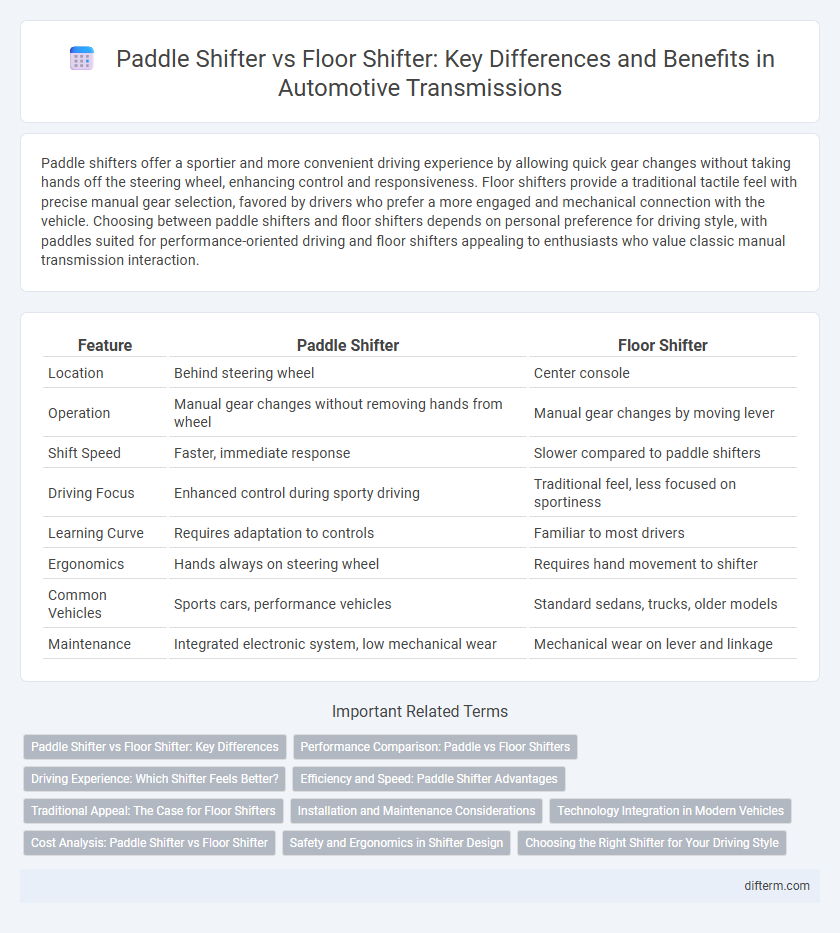Paddle shifters offer a sportier and more convenient driving experience by allowing quick gear changes without taking hands off the steering wheel, enhancing control and responsiveness. Floor shifters provide a traditional tactile feel with precise manual gear selection, favored by drivers who prefer a more engaged and mechanical connection with the vehicle. Choosing between paddle shifters and floor shifters depends on personal preference for driving style, with paddles suited for performance-oriented driving and floor shifters appealing to enthusiasts who value classic manual transmission interaction.
Table of Comparison
| Feature | Paddle Shifter | Floor Shifter |
|---|---|---|
| Location | Behind steering wheel | Center console |
| Operation | Manual gear changes without removing hands from wheel | Manual gear changes by moving lever |
| Shift Speed | Faster, immediate response | Slower compared to paddle shifters |
| Driving Focus | Enhanced control during sporty driving | Traditional feel, less focused on sportiness |
| Learning Curve | Requires adaptation to controls | Familiar to most drivers |
| Ergonomics | Hands always on steering wheel | Requires hand movement to shifter |
| Common Vehicles | Sports cars, performance vehicles | Standard sedans, trucks, older models |
| Maintenance | Integrated electronic system, low mechanical wear | Mechanical wear on lever and linkage |
Paddle Shifter vs Floor Shifter: Key Differences
Paddle shifters offer rapid, hands-on-wheel gear changes enhancing driver control and safety, commonly found in sports and high-performance vehicles. Floor shifters provide a traditional gear-changing experience, typically allowing for more precise manual input and often associated with conventional manual transmissions. Key differences include response time, ergonomics, and driving dynamics, with paddle shifters enabling quicker shifts and floor shifters delivering tactile feedback favored by driving enthusiasts.
Performance Comparison: Paddle vs Floor Shifters
Paddle shifters offer quicker gear changes by allowing drivers to shift without removing their hands from the steering wheel, enhancing control during high-performance driving. Floor shifters provide a more tactile and traditional shifting experience, often preferred in muscle cars for precise manual engagement. Performance-wise, paddle shifters excel in rapid response and convenience, while floor shifters deliver greater mechanical feedback and driver engagement.
Driving Experience: Which Shifter Feels Better?
Paddle shifters offer a sportier driving experience by enabling quick, seamless gear changes without removing hands from the steering wheel, enhancing control and responsiveness. Floor shifters provide a more traditional, tactile feel that many drivers prefer for its precise mechanical feedback and engagement. The choice between paddle shifter and floor shifter ultimately depends on driver preference for convenience and modern performance versus classic shifting sensation and involvement.
Efficiency and Speed: Paddle Shifter Advantages
Paddle shifters enable quicker gear changes by allowing drivers to maintain both hands on the steering wheel, enhancing control and reducing shift times compared to traditional floor shifters. This design improves driving efficiency, especially in performance vehicles where split-second gear transitions affect acceleration and lap times. The electronic actuation system in paddle shifters also minimizes mechanical lag, providing more precise and consistent shifts under various driving conditions.
Traditional Appeal: The Case for Floor Shifters
Floor shifters maintain a traditional appeal in automotive design by offering tactile feedback and a mechanical connection that many driving enthusiasts prefer for precise gear control. This setup provides a more engaging driving experience by enabling deliberate gear changes, often favored in sports cars and classic vehicles. Compared to paddle shifters, floor shifters reinforce driver involvement through physical interaction with the transmission system, preserving a sense of authenticity in driving dynamics.
Installation and Maintenance Considerations
Paddle shifters require integration with the vehicle's electronic control system, demanding precise calibration and expert installation to ensure smooth gear transitions, often found in modern automatic transmissions. Floor shifters involve mechanical linkage installation, which can be simpler but may require more frequent maintenance due to physical wear and potential misalignment. Maintenance for paddle shifters typically involves software updates and electronic component checks, while floor shifters need regular lubrication and adjustment of mechanical parts to maintain optimal performance.
Technology Integration in Modern Vehicles
Paddle shifters integrate advanced electronic sensors and hydraulic systems to enable seamless gear changes with minimal driver effort, enhancing the driving experience in modern vehicles. Floor shifters, while traditional, are increasingly equipped with electronic shifting mechanisms to improve precision and responsiveness. The adoption of paddle shifters reflects the trend towards digital and automated control systems that prioritize efficiency and driver engagement.
Cost Analysis: Paddle Shifter vs Floor Shifter
Paddle shifters generally incur higher manufacturing and installation costs due to their integration with advanced electronics and steering column mechanisms, whereas floor shifters remain more cost-effective with simpler mechanical linkages. Maintenance expenses for paddle shifters can be elevated because of their reliance on electronic sensors and actuators, contrasting with the lower upkeep costs typical of floor shifters. From a cost analysis perspective, budget-conscious automotive designs often favor floor shifters, while premium models prioritize paddle shifters despite the increased expense for performance and user experience benefits.
Safety and Ergonomics in Shifter Design
Paddle shifters enhance safety by allowing drivers to keep both hands on the steering wheel, reducing reaction time during gear changes and minimizing distraction. Ergonomically, paddle shifters positioned behind the steering wheel optimize hand placement, preventing unnecessary movement and reducing fatigue compared to floor shifters that require reaching down and shifting focus. Floor shifters, while traditional, often demand more physical effort and longer eye diversion, potentially compromising driver control and safety during dynamic driving conditions.
Choosing the Right Shifter for Your Driving Style
Paddle shifters offer precise gear changes and faster response times, ideal for performance-focused driving and sporty handling. Floor shifters provide a more tactile and traditional manual shifting experience, preferred by drivers seeking greater control and engagement. Choosing the right shifter depends on whether you prioritize speed and convenience with paddle shifters or a classic, immersive driving feel with floor shifters.
paddle shifter vs floor shifter Infographic

 difterm.com
difterm.com